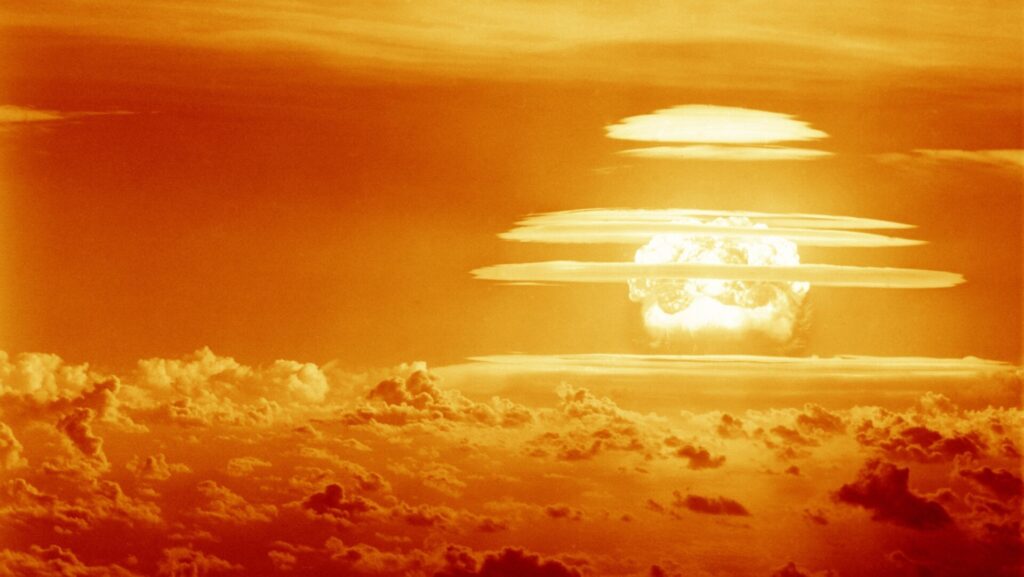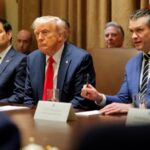Between Donald Trump’s words and his actions falls the nuclear shadow.
Yesterday while speaking in the Oval Office, President Trump fantasized about cutting the U.S. military budget in half and stressed the need to get rid of nuclear weapons. “There’s no reason for us to be building brand new nuclear weapons, we already have so many,” he said. “You could destroy the world 50 times over, 100 times over. And here we are building new nuclear weapons, and they’re building nuclear weapons.”
He’s not wrong, but listening to him say it made blood ooze from my ears. There’s a strong argument that no single person has made the world more dangerous regarding nuclear weapons than Trump. He spent much of his first presidency shredding the last vestiges of Cold War-era treaties and norms that had kept nuclear weapons in check for decades.
Total global nukes peaked in 1986 at around 60,000 weapons. Most of those belonged to the U.S. and the Soviet Union. Then a long line of world leaders, starting with Ronald Reagan and Mikhail Gorbachev started to draw down. A series of treaties, talks, and mutual cooperation across the plant—but especially between the U.S. and Russia—reduced the amount of nuclear weapons in the world.
Experts estimate that there are now around 12,100 nukes. Just like in 1986, most of those weapons are in Russia and America. And the drawdown trend is reversing. China, which has sat on around 300 nukes for decades, is building more. Russia is constructing new and different kinds of nuclear weapons. The U.S. is spending $2 trillion to “modernize” its nuclear forces, a project that will involve new nuclear-armed submarines and costly new missile silos.
Trump didn’t start these trends, but he did supercharge them.
President Obama negotiated a deal with Iran to keep the country from developing nuclear weapons. Under the Joint Comprehensive Plan of Action (JCPOA) the International Atomic Energy Agency (IAEA) would have access to Iranian nuclear sites and Tehran would draw down its nuclear weapons ambitions. America would, in exchange, reduce sanctions and live weapons embargos after a few years.
When Trump became president he pulled out of the deal. Tehran is now much less interested in making a deal with the U.S. and much more interested in acquiring a nuclear weapon. Israel, emboldened by recent military victories, is considering a strike on Iranian nuclear facilities. Trump turned diplomacy into violence.
Not content, Trump then unilaterally pulled out of the Intermediate-Range Nuclear Forces (INF) Treaty. The Reagan-era treaty limited the amount of ground-launched ballistic and cruise missiles the U.S. and Russia could deploy with ranges of 310 to 3,420 miles. It covered both nuclear and conventional warheads. Trump said he was pulling out because Russia was breaking the rules. Now no one is abiding by the treaty. It’s dead.
Then Trump withdrew the U.S. from the Open Skies Treaty. Established in 1992, Open Skies allows rival nations to fly aircraft above a rival country to make sure they’re not preparing for war. It was an invitation to spy on each other, in the open, to make sure everyone was keeping their promises. It was “trust but verify” encoded into a pact between nations. Again the risk of nuclear war ratched up.
The last remaining arms control treaty between the U.S. and Russia is the New Strategic Arms Reduction Treaty (START). Similar to the INF, it put a limit on deployed strategic nuclear warheads. It will expire next year unless both sides agree to renew it, but it’s effectively dead. Russia suspended its participation in the treaty in 2023. Trump, as was typical of him at the time, spent his first presidency trashing it. He called it a bad deal and said it wasn’t good unless China was part of it.
Nuclear weapons are world-ending weapons. Limiting their use and reducing their number requires delicate and extraordinary trust between rival countries. The treaties weren’t just verbal agreements, but complex documents that created monitoring regimes. Russia would send experts to the U.S. to make sure it was keeping up its end of the bargain and vice-versa. It was an invocation between opponents to make sure everyone was playing fair.
Trump has consistently complained that China wasn’t a part of these treaties, and it’s important to remember that the U.S. and Russia have more than 5,000 nukes each. China has around 500. Beijing has met Trump’s request for them to join arms reduction treaties with the same repeated sentiment over the last 10 years: “You first.”
This regime of checks and balances between nuclear countries sent signals to other nations on the planet: The risk of nuclear hellfire is reducing. A country or a leader pursues a nuclear weapon program because it doesn’t want someone else to launch a nuke against it and it doesn’t want someone else to conquer it.
A nuclear-armed country has invaded Europe. The U.S. President is saying he’ll spend less on defense and he’s spent his entire political career shredding nuclear treaties. No one is watching the nuclear till. Russia and the U.S. are no longer inspecting each other. Both countries are free to spend as much on nuclear weapons as they want and are in the process of doing so.
It doesn’t matter what Trump says, off the cuff, while sitting behind the Resolute Desk. It matters what he does. And all he’s done is make the world safer for nuclear weapons and more dangerous for the people living in it.







